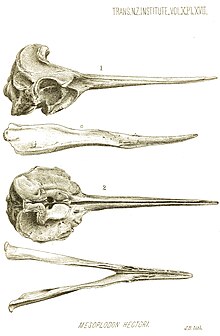Hector's beaked whale
| Hector's beaked whale | |
|---|---|

| |

| |
| Size compared to an average human | |
| Scientific classification | |
| Domain: | Eukaryota |
| Kingdom: | Animalia |
| Phylum: | Chordata |
| Class: | Mammalia |
| Order: | Artiodactyla |
| Infraorder: | Cetacea |
| Family: | Ziphiidae |
| Genus: | Mesoplodon |
| Species: | M. hectori
|
| Binomial name | |
| Mesoplodon hectori (Gray, 1871)
| |

| |
| Hector's beaked whale range | |
Hector's beaked whale (Mesoplodon hectori), is a small mesoplodont living in the Southern Hemisphere. This whale is named after Sir James Hector, a founder of the colonial museum in Wellington, New Zealand. The species has rarely been seen in the wild.
Some data supposedly referring to this species, especially juveniles and males, turned out to be based on the misidentified specimens of Perrin's beaked whale - especially since the adult male of Hector's beaked whale was only more recently described.[3][4][5][6][7][8][9][10][11][12]
Taxonomy
The English taxonomist
Molecular Taxonomy

With abundant and easily observable species, the use of
Description
Reaching a maximum length around 4.2 m (1.9 m when born), and with an estimated weight around 1 tonne (1.032 tons), Hector's is one of the smallest of the beaked whales. It is known from only a few stranded animals and a single confirmed sighting of a juvenile off Western Australia.[1] Hector's beaked whales are dark greyish-brown dorsally, paler ventrally. A single female specimen found in Argentina was light grey dorsally and white ventrally.[19] An individual male described in the same study had several scars and teeth marks found diffuse on its back and flanks. Intra-specific male-to-male interactions are possibly the cause for such marks. Additionally, oval white scars on the ventral portion of this male specimen were likely caused from cookie-cutter sharks of the Isistius species. Another single adult male specimen had a white beak and white on the anterior portion of the head, with white, linear scars criss-crossing its body, while the juvenile seen off Western Australia had a mask covering its eyes and extending unto its melon and upper beak. The melon, which is not very prominent, slopes quite steeply to the short beak. The dorsal fin is triangular to slightly hooked, small, and rounded at the tip. The leading edge of the dorsal fin joins the body at a sharp angle.
Stomach
Like other members of the
Dentition
Adult males have a pair of flattened, triangular teeth near the tip of the lower jaw. As with most other beaked whales, the teeth do not erupt in females.
In March 2016, the South Australian Museum conducted a necropsy on a beached female specimen of the species from Waitpinga beach, near Adelaide, South Australia. The specimen was found to have a pair of large fangs not seen among the species typical dentition, especially for females, who typically have none. The fangs are possibly vestigial, or atavisms of some other kind, though a definitive answer is difficult because of the dearth of knowledge about the species.[21]
Distribution and ecology
Hector's beaked whale has a circumpolar distribution in cool temperate Southern Hemisphere waters between about 35 and 55°S. Most records are from New Zealand, but also reports from Falkland Sound, Falkland Islands, Lottering River, South Africa, Adventure Bay, Tasmania, and Tierra del Fuego, in southern South America have been made. Supposed Northeast Pacific records in the older literature actually refer to Perrin's beaked whale.
Sightings are rare due to their deep-ocean distribution, elusive behaviour and possible low numbers. Nothing is known about the diet of this species, although it is assumed to feed on deepwater squid and fish. Because they lack functional teeth, they presumably capture most of their prey by suction.
Body scarring suggests there may be extensive fighting between males, which is common in beaked whales. Nothing is known about breeding in this species.
This species has never been hunted at all, and has not entangled itself in fishing gear. Most records of the whale have been stranded specimens on beaches, particularly in New Zealand.
Conservation
Hector's beaked whale is covered by the Memorandum of Understanding for the Conservation of Cetaceans and Their Habitats in the Pacific Islands Region (Pacific Cetaceans MOU).[22]
Specimens
- MNZ MM001834 - 16 July 1980; Kaikoura, New Zealand
See also
References
- ^ . Retrieved 19 November 2021.
- ^ "Appendices | CITES". cites.org. Retrieved 2022-01-14.
- ^ JSTOR 1380733.
- ^ Mead, James G. (1984). "Survey of reproductive data for the beaked whales (Ziphiidae)" (PDF). International Whaling Commission Special Issue. 6: 91–96.
- .
- JSTOR 2403599.
- ^ Jefferson, T.A.; Leatherwood, S.; Webber, M.A. (1993). FAO species identification guide: Marine mammals of the world (PDF). United States & Rome: United States Environment Programme & Food and Agriculture Organization of the United Nations (FAO).
- ^ a b c Mead, James G. (1993). "The systematic importance of stomach anatomy in beaked whales" (PDF). IBI Reports. 4: 75–86.[permanent dead link]
- ISBN 0004722736.
- ISBN 2-8317-0189-9.
- .
- PMID 12064244.
- ISSN 0374-5481.
- ISSN 0303-6758.
- ISSN 0033-5770.
- ISSN 0007-5167.
- ^ PMID 15475391.
- ^ ISSN 0824-0469.
- ^ ISSN 2236-1057.
- S2CID 22848752.
- LiveScience. Retrieved 2016-08-13.
- ^ Official webpage of the Memorandum of Understanding for the Conservation of Cetaceans and Their Habitats in the Pacific Islands Region
Further reading
- Baker, Alan N. (1990): Whales and dolphins of New Zealand and Australia: An identification guide. Victoria University Press, Wellington.
- Perrin, William F.; Wursig, Bernd & Thewissen, J.G.M (eds.) (2002): Encyclopedia of Marine Mammals. Academic Press. ISBN 0-12-551340-2
- Reeves, Randall R.; Steward, Brent S.; Clapham, Phillip J. & Owell, James A. (2002): Sea Mammals of the World. A & C Black, London. ISBN 0-7136-6334-0

